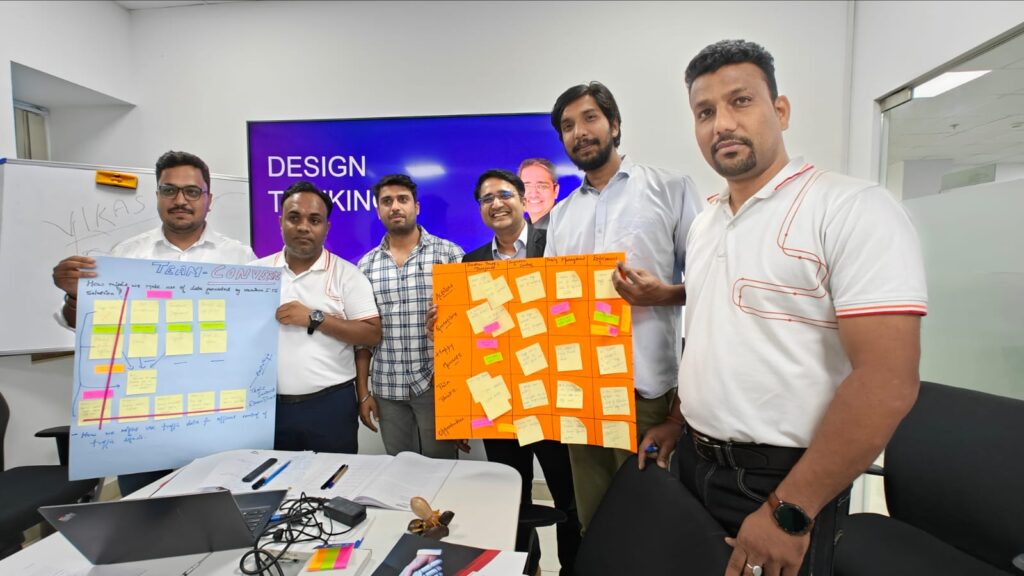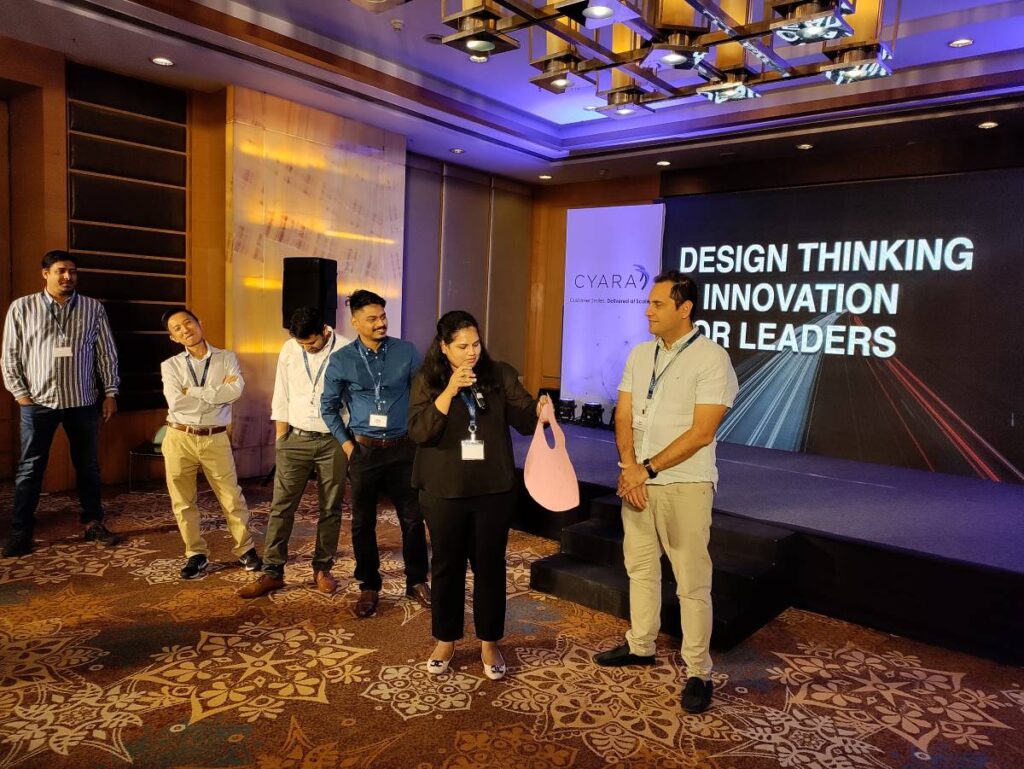Vikas Jain has delivered workshop and session on Design Thinking & Innovation. He is based out of Delhi and has delivered session in Delhi, Noida, Pune and other cities. He is a global speaker & author.
Customer Centriticity means putting the customer first and at the center of everything that you do. Customer centricity is not just customer servicing, because it involves a more holisitc organization-wide strategy. Whether it’s about building products or designing services, a customer-centric organization put customer at the center of each and every decision.
Design Thinking is an innovation based, human centered approach to build world-class products & services. It has been researched by leading institutions like Stanford School of Design, IDEO, adapted by leading organization like IBM Design Thinking, Google Sprint by Google Ventures to name few and practiced by fortune 500 corporations like PepsiCo and many more.

Vikas is a Design Thinking Coach & Facilitator. He is also working with a leading organization to design & deliver “Design Thinking for Boardroom” program. Vikas extensively incorporate innovative & experiential online tools like Miro during virtual & physical workshops on Design Thinking.
Vikas is creator of Vikas World-Class Quadrant & Framework, a strategic approach to deliver World-Class Products & Services. He is having 16+ years of corporate experience. He is also a Growth & Innovation Consultant and previously worked with IBM & McAfee. He did MCA from University of Delhi & B.Sc from Hansraj College.


Design Thinking is not just for professionals but equally important for leaders and that’s why the world’s leading institutions are offering executive development programs in Design Thinking and Innovation.
“Design thinking gives leaders a structured and systematic way to build a culture of innovation within their organizations” – IIM Bangalore
Leader's view on design thinking
“We do design thinking to help us accelerate and enable innovation, I think. Innovation is a tough enough job as it is, so we need tools and we need approaches and methods to help us do it more effectively.
When it comes down to it, business is about people. And it’s about what people want and don’t want. And if you take the time to understand what people want, then I think you get a successful business, and that’s the essence of what design thinking is about. It’s to get closer to people, so you can understand what they really, really want, and make that sustainable and viable.
– Gary Etheridge – Director of Design (Nestlé Purina PetCare)
We’re seeing projects that are moving very, very quickly, they’re punching through where they couldn’t punch through in the past. Innovations making it into customers’ hands. Like right now, we have several that are being tested, and moving through a prototype stage. And some of these innovations are products, but others are just in-house. We’re applying design thinking not just to our products that we build for customers, but to every part of the business.
– Saul Gurdus – VP of Insights & Enablement (Citrix)
Design thinking - overview
Design thinking is a problem-solving approach that focuses on understanding user needs, generating creative ideas, and prototyping and testing solutions. It is a human-centered and iterative process that encourages empathy, collaboration, and experimentation. Here are some key concepts and steps involved in design thinking:
Empathize: Understand the needs and perspectives of the people you are designing for. Conduct interviews, observations, and gather user insights to develop empathy for their experiences.
Define: Clearly define the problem or challenge you are trying to address based on the insights gained during the empathize stage. Create a problem statement that focuses on the user’s needs.
Ideate: Generate a wide range of creative ideas to solve the defined problem. Encourage brainstorming sessions, sketching, and other techniques to stimulate innovative thinking.
Prototype: Create tangible representations of your ideas. Develop rough models, sketches, storyboards, or even interactive digital prototypes to bring your concepts to life.
Test: Gather feedback on your prototypes from the target users and stakeholders. Evaluate the usability, effectiveness, and desirability of the solutions. Iterate and refine based on the feedback received.
Implement: Once you have a validated solution, develop an implementation plan and execute it. Consider factors such as feasibility, viability, and sustainability during this stage.
Throughout the design thinking process, it’s crucial to maintain an iterative mindset, embracing failures as learning opportunities and continuously refining your ideas based on user feedback.
Design thinking trainer
As a design thinking trainer, there are several key requirements and skills that are beneficial for effectively teaching and facilitating design thinking processes. Here are some essential requirements for a design thinking trainer:
Expertise in Design Thinking: Possess a deep understanding of design thinking principles, methodologies, and tools. Stay updated with the latest trends and advancements in the field to provide relevant and valuable training.
Strong Facilitation Skills: Be skilled in facilitating group discussions, brainstorming sessions, and collaborative activities. Create an inclusive and supportive environment that encourages active participation and creative thinking.
Excellent Communication Skills: Clearly articulate complex concepts and ideas to diverse audiences. Present information in a concise and engaging manner, both orally and in writing. Effective communication fosters understanding and engagement among learners.
Empathy and User-Centered Mindset: Demonstrate empathy towards learners and emphasize the importance of understanding user needs and perspectives. Encourage a user-centered approach throughout the training process.
Adaptability and Flexibility: Be adaptable to different learning styles, organizational contexts, and industries. Tailor the design thinking training to meet the specific needs and challenges of the participants.
Problem-Solving and Analytical Skills: Possess strong problem-solving abilities and analytical thinking. Help participants break down complex problems, identify root causes, and generate innovative solutions using design thinking techniques.
Experience with Real-World Design Challenges: Have practical experience in applying design thinking to real-world projects and challenges. Share relevant case studies, examples, and success stories to illustrate the effectiveness and impact of design thinking.
Continuous Learning and Growth Mindset: Embrace a mindset of continuous learning and improvement. Stay curious and open to new ideas, methodologies, and emerging trends in design thinking.
Collaboration and Teamwork: Foster a collaborative and inclusive learning environment. Encourage participants to work in teams, share ideas, and leverage the collective intelligence of the group.
Evaluation and Feedback: Incorporate evaluation mechanisms to assess the effectiveness of the training. Gather feedback from participants to continuously enhance the training experience and make necessary adjustments.
Remember, while possessing these requirements is important, continuous self-development and staying up-to-date with design thinking practices will further enhance your effectiveness as a design thinking trainer.
